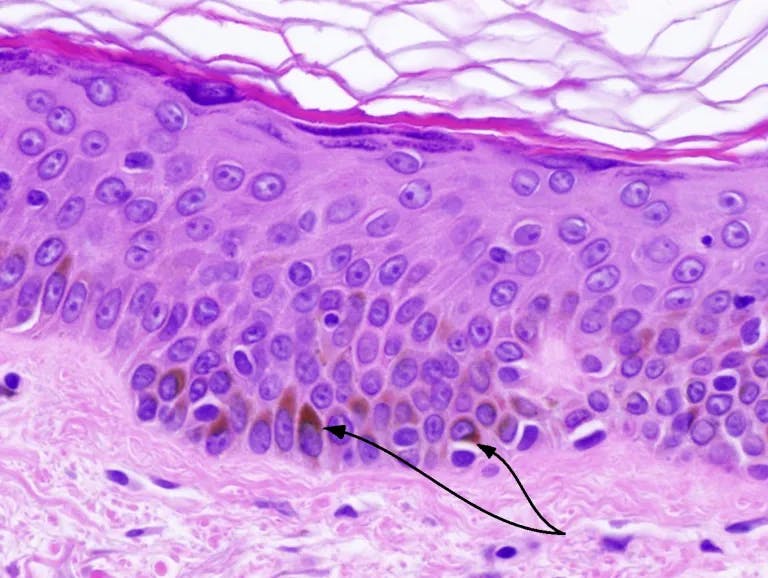Race
We all have melanocytes. And all of us make melanin (except albino people. And I mean real albino people – people who have a defective melanin gene, not just fair-skinned people like my wife who will blind you first thing in the spring). What determines skin color is how much melanin those cells make. That’s it.
Since I am going to talk about race – and I mean that I am going to go way down this bumpy road over time- the most important thing for you to understand is where I am coming from. This is foundation stuff, and we need to be on the same page.
I deal with race everyday. I see it, I act on it, I make decisions about people based on race in my job all the time. So I took a picture, and even put some arrows on it:

That’s my view of race, right there. See that brown pigment? That’s called melanin. That’s what determines race. And that, my friends, should answer all of your questions, and help you to understand why race is such a s big deal. What? Not so much? Weird. I thought it would be obvious. Then let me explain:
This is a picture of a histologic section of skin from a random case at our lab. The slide is stained with our routine stain called hematoxylin and eosin, which a fancy way of saying blue and pink. The purpley middle part is the growing skin layer, made of of cells called keratinocytes (because they make keratin). They are constantly being reproduced at the bottom, and slowly migrate up to the middle where they stick together as they die to make nice water-tight seal to protect you from the outside world. That top “basket weave”-looking part is that dead layer of skin (keratin) that you can kinda slip a needle under and it doesn’t hurt.
At the bottom, there are little cells admixed called melanocytes (because they make melanin). They look more like dark blue dots with clear space around them (there are 3 or 4 of them). In reality, they have these long fingers that you can’t see that reach out and touch all of the keratinocytes at the base of the skin.
The job of the melanocyte is to put melanin hats on your skin cells. They even look like little hats, don’t they? These hats protect the cells from the damaging rays of the sun. So they really are like little hats…
We all have melanocytes. And all of us make melanin (except albino people. And I mean real albino people – people who have a defective melanin gene, not just fair-skinned people like my wife who will blind you first thing in the spring). What determines skin color is how much melanin those cells make. That’s it. It’s not a different kind, it’s not a different cell, it simply comes down to how much gets made into hats.
The “how much” part is determined by a set of genes, and because these genesare inherited, the amount of production gets handed down with them. Which is to say, you tend to look like your parents.
Because melanin is designed to protect you from the damaging rays of the sun, exposure to those rays stimulates the production of hats. But hat production is kinda variable. I make hats really well, and despite the current “never-seen-the-sun” look of my pale posterior, I can build up quite a tan. Getting a tan is the colloquial way of saying “make hats.” My wife doesn’t make hats, though she like to pretend she does.
I gave up making hats in residency, when I started seeing what UV rays do to your skin. It’s not pretty. Even now, I get distraught athow I am starting to look, well, old. UV does that. So I wear sun screen like nobody’s business, as do most people “in the business” (pathology, dermatology).
Hats protect you from this damage. So people who have lots of really good hats don’t need sun screen. Which is cool, actually, because sun screen is rather a pain in the arse to have to deal with all the time when you’d rather be outside having fun. And despite being old and now somewhat wrinkly, I still like to go outside and have fun.
So to me, my view of race is actually tinged with a bit of jealousy. Because, if I were buying a body at the dealership and going through the options list, I would be pretty interested in the hat option. No sunscreen, greatly reduced incidence of skin cancer. And if you take the time and look at the skin of older people with darkly pigmented skin, it looks smoother and younger. Yes, I think I would tick the “hat” box.
That’s my view of race. Oversimplified? No, sorry, it’s not at all. For certain, this is not the same way some people see it. But then, we used to think the world was flat. But what I have shown here is the fundamental definition of race. Everything else is a construct applied by society, and none of it has any basis in reality. The reality is that skin color is dueto one thing: hats.